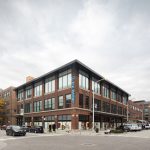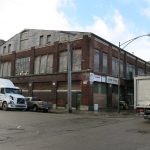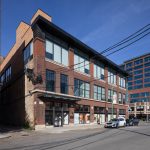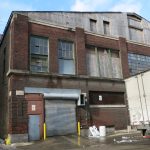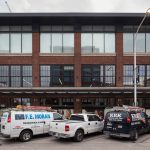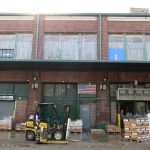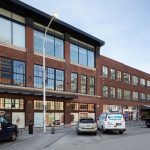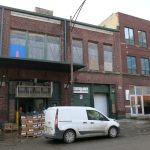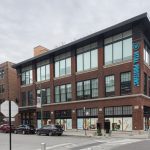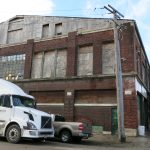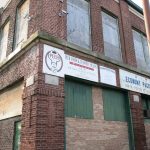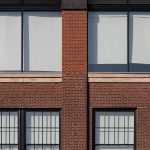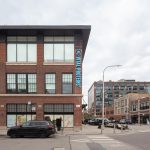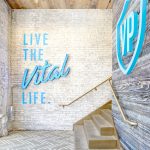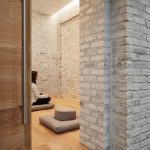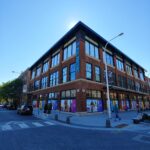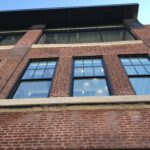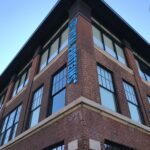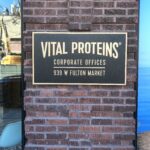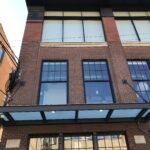Many factors influenced Chicago’s rapid growth from frontier settlement to sprawling city, but its effective centralized processing of agriculture is what infamously captured public attention and turned the eyes (and stomachs) of the world to the activities of this Midwestern metropolis.
Vast quantities of produce and livestock flowed into the city from the fields of the West, forcing construction of large wholesale markets where the goods could be consolidated, sorted, packaged, and distributed for sale. Complementing the work of Chicago’s expansive stockyards, the Fulton Market District emerged around 1850 as an enclave for meatpacking businesses to prepare goods for dispersal citywide and out to the East Coast.
It was in 1917, at the peak of the district’s construction heyday, that 939 W Fulton’s brick edifice was built. Economy Packing Company would call the building home for the better part of the next century, advertising their wares with simple exterior signage reading “Bacon, Sausage Links & Patties, Ham, Corned Beef.”
In 2015, the city designated the Fulton-Randolph Market District as a protected historic area, including 939 Fulton as a contributing property. Capitalizing on the classification, Economy Packing sold its properties to a developer and moved to a much larger, modern facility. The aging, outdated buildings had hampered business for too long — without loading docks, workers had unloaded trucks of meat with fast-moving forklift teams, often at war with the city’s weather extremes.
A facade consultant (Revive Architecture) and two architectural firms (Hartshorne Plunkard Architecture for the exterior and Solomon Cordwell Buenz for the interior) embarked on an exhaustive renovation of the two-story brick and timber building, working within landmark guidelines. Damaged structural components had to be repaired and upgraded to withstand the weight of an additional third level and new, vintage-style cornice. A full gut rehab was required to retrofit the building into contemporary office space. Inside and out, the traditional masonry walls needed extensive restoration and infills with in-kind material.
Seeking products that would mimic the original brickwork as closely as possible, the design team turned to our staff for help. Three distinct materials were eventually approved for use on the project. An old-school 8” red brick with smashed vertical-scratch texture, supplied by Ragland Clay Products, was matched to a clean section of the exterior face brick and used to extend the façade vertically. Reclaimed Chicago common brick cut to ½” thickness was supplied for interior applications and later whitewashed — an authentic twin of the building’s now-exposed inner wythe. Lookalike material from McNear was used elsewhere inside, while products from a third manufacturer can be seen on the alley-facing southern elevation, cladding the back wall of the new top floor as well as the elevator shaft that peeks out above the building’s roofline.
Today, Fulton Market is a thriving neighborhood occupied by tech companies, trendy hotels, forward-thinking businesses, fashionable restaurants, boutiques, and buzzy cocktail bars. At 939 Fulton, pork processing has given way to the offices of California-based nutrition company Vital Proteins. While industrial entities in the district are now few and far between, thoughtful adaptive reuse projects like this one have preserved its historic atmosphere and remind the community of its storied roots.
Location: 939 W Fulton Market, Chicago, IL
Read more on Curbed Chicago.
See interior photos & read more on Office Envy.
Read more about the interior via Architect Magazine.
Architect: Hartshorne Plunkard Architecture
Facade Consultant: Revive Architecture
Mason: Mark 1 Restoration
Interior: Solomon Cordwell Buenz
Products supplied: Ragland Clay Products (exterior), Chicago Common Reclaimed Brick (interior) and McNear Brick (interior)
Categories: Reclaimed Materials, Commercial + Municipal, Historic Preservation + Adaptive Reuse, Face Brick, Thin Brick + Thin Stone, Fireplaces + Brick Interiors
